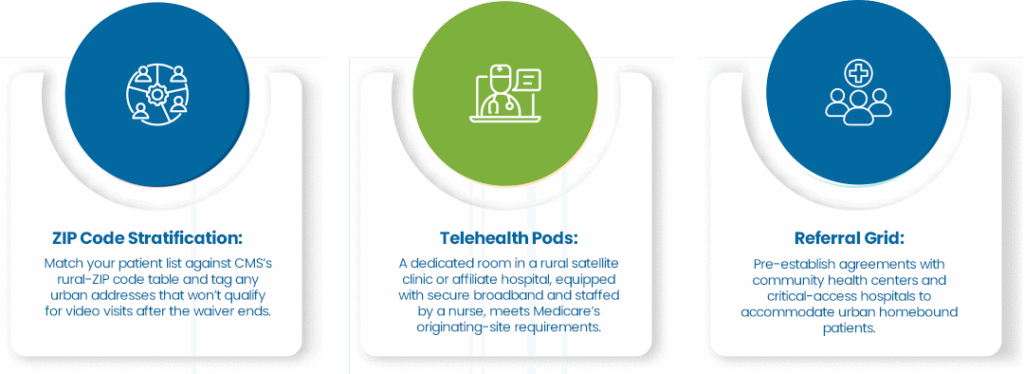Will one line in the Medicare Final Rule erase an entire revenue stream from your internal-medicine billing ledger overnight? Imagine: it’s October 1, 2025. You open your dashboard expecting the usual deposit, but instead you see a wall of denials stamped “NON-PAYABLE — AUDIO-ONLY.” The claims that just yesterday generated $50 apiece are suddenly classified as non-covered. For a practice averaging 20 telephone encounters per workday, that’s more than $240,000 in annual revenue gone before your coffee cools.
Why the abrupt shift suddenly? It is because on Sept 1, 2025, Medicare’s pandemic-era flexibilities officially expire. Stand-alone telephone evaluation codes are decommissioned, Modifier 93 loses its applicability, and geographic and originating site requirements are reinstated—restricting most telehealth services to rural facilities and requiring real-time video communication. Furthermore, commercial insurers typically align with Medicare policy within one fiscal quarter, extending the financial and operational impact well beyond Medicare patient panels.
This article provides a comprehensive analysis of key regulatory changes from the retirement of CPT codes 99441–99443 to the implementation of the G2211 complexity add-on and their combined impact on internal medicine billing. We’ll break down the policy language into actionable guidance, assess the financial implications for both solo practitioners and group practices, and offer a strategic toolkit of coding adjustments, workflow enhancements, and technology integrations designed not only to offset the loss of audio-only visit revenue but to enhance overall profitability.
How will This Change Affect Your Internal Medicine Billing Practices?
When Medicare ends payment for phone-only visits, internal medicine clinics will suddenly see a once-steady revenue stream disappear while denied claims pile up. What was once a simple, reimbursable check-in under internal medicine billing guidelines becomes an unpaid service draining staff time and skewing your accounts receivable (A/R) metrics. Guiding patients toward secure video or in-person care safeguards your cash flow and shows you’re still there for them. Acting now ensures a compliant transition and keeps trust intact.

- Revenue at risk: Each audio-only visit currently reimburses roughly $48–$50. Losing just 20 daily calls could slash more than $250K annually for a solo internist.
- Denial surge: Any claim sent after September 30 with Modifier 93 (or the old G-codes) will be rejected automatically, forcing extra rework and driving up your A/R days.
- Patient experience risk: People who rely on fast phone check-ins may feel dropped if you don’t guide them smoothly into video or in-person visits.
What Telehealth Compliance & Revenue Protection Roadmap Should You Follow Now?
Below is a streamlined guide for your internal medicine billing to fast-track profitability amid changing and compliance regulations in telehealth after September 2025.
Regulatory Timeline and Implications
Medicare is phasing out payments for phone-only visits, then ending the special billing modifier, and finally requiring most video visits to start in rural facilities, so internal-medicine practices need to adjust their billing and visit workflows ahead of each deadline.
| Effective Date | Regulatory Change | Consequences for Internal Medicine Billing |
| 1 Jan 2025 | Pandemic telephone codes 99441-99443 retired; Medicare declines to adopt AMA audio-only set 98008-98015 | Elimination of stand-alone telephone E/M codes |
| 1 Jan 2025 | CMS activates G2211 complexity add-on | Average $16 payment increase for qualifying established-patient visits |
| 30 Sep 2025 | Medicare ends reimbursement for audio-only office E/M claims submitted with modifier 93 (non-behavioral health) | Telephone encounters become categorically non-payable |
| 1 Oct 2025 | Geographic and originating-site waivers expire | Most Medicare video visits must originate in a rural facility; an urban home as a site of service becomes non-compliant |
Because commercial payers typically harmonize their payment edits with Medicare within one to three calendar months, internal medicine billing teams should also expect a rapid increase in private-payer denials. Staying ahead of these policy shifts is essential to protect your clinic’s revenue integrity and streamline denial management
Quantifying Revenue Exposure
Building on the timeline above, we now convert those cutoff dates into projected revenue losses; so you can see, in plain dollars, what’s at stake each month and across a full year once phone-only visits disappear.
| Practice Profile | Daily Telephone Visits | Allowable per Visit | Monthly Exposure* | Annual Exposure* |
| Solo internist | 20 | $50 | $22,000 | $264,000 |
| Five physicians, two NPs | 70 | $48 | $74,000 | $888,000 |
*Assumes 22 clinical workdays per month.
Beyond direct write-offs, organizations will incur secondary costs: elevated accounts receivable days, increased denial management workload, and additional staff time dedicated to patient rescheduling.
Strategic Response: Migration from Audio to Video
Phone-only visits won’t pay after Sept 30, so move fast to two-way video. Medicare still reimburses real-time audio-video and counts it as “direct supervision” if the supervising doctor can jump on screen. Start by reviewing recent Modifier-93 claims to see who still relies on the phone, then make every follow-up “video-first” and reserve the phone for rare tech failures.
Equip rooms with webcams, keep a few loaner tablets for patients, add a quick connection test to reminder calls, and set your EHR to flag non-video appointments and strip 93 after the cutoff. These simple steps safeguard most of the revenue at risk and keep you fully compliant.
A. Utilization Analysis
Generate a six-month report detailing:
- CPT 99441-99443 volume.
- Office E/M codes 99202-99215 appended with modifier 93.
Segment results by provider and chronic-disease cohort to identify the highest-risk patients.
B. Scheduling Protocol
Adopt a “video-first” policy to align with current internal medicine billing compliance standards. Telephone appointments should be reserved only for connectivity failures or specific clinical exceptions. Your electronic health record (EHR) system should flag audio-only visit requests to prompt a billing compliance review, helping internal medicine practices reduce audit risks and ensure accurate reimbursement.
C. Technical Enablement
Invest in cost-efficient hardware:
- High-definition webcams for each examination room.
- Loaner tablets with prepaid data plans for homebound Medicare beneficiaries
- Standardized workflows that guide medical assistants through a three-minute video connectivity rehearsal during reminder calls
Conversion of even 60 percent of telephone encounters to synchronous video retains approximately 75 percent of otherwise lost revenue.
Coding Adjustments to Offset Margin Loss
Leveraging Remote Physiologic Monitoring, Remote Therapeutic Monitoring, and Chronic Care Management keeps clinicians connected to high-risk patients while creating a predictable, month-over-month revenue stream. Enrolling even a small slice of your panel can quickly backfill the dollars lost when audio-only visits disappear in internal medicine billing.
- G2211 Complexity Add-On
- Who qualifies? Established outpatients who need ongoing, complex care are the patients you see again and again for multiple or chronic conditions.
- How to trigger it? Build a quick, mandatory pop-up in your EHR. When the visit meets the complexity rules, the system adds G2211 to the claim and drops the required note elements into the chart automatically.
- Why bother? Logging just 30 qualifying encounters a week can add roughly $24,000 a year in extra revenue without changing your clinical workflow.
- Remote Monitoring and Chronic-Care Management
- Remote Physiologic Monitoring (RPM): 99454–99458
- Remote Therapeutic Monitoring (RTM): 98976–98981
- Chronic Care Management (CCM): 99490–99491
These services remain payable and are unaffected by the audio-only sunset in internal medicine billing. Integrating an RPM or CCM pathway for even 10 percent of the patient panel typically compensates for lost telephone revenue within one fiscal quarter.
Preparing for the Geographic Waiver Rollback
When public-health flexibilities end, Medicare video visits must originate in rural sites (with limited exceptions).

- ZIP Code Stratification: Match your patient list against CMS’s rural-ZIP code table and tag any urban addresses that won’t qualify for video visits after the waiver ends.
- Telehealth Pods: A dedicated room in a rural satellite clinic or affiliate hospital, equipped with secure broadband and staffed by a nurse, meets Medicare’s originating-site requirements.
- Referral Grid: Pre-establish agreements with community health centers and critical-access hospitals to accommodate urban homebound patients.
Documentation and Modifier Compliance
Use the matrix below to match every telehealth encounter with the correct modifier and note elements, ensuring your claims are clear on the first pass.
| Service Date | Modality | Required Modifier | Documentation Elements |
| Till 30 Sep 2025 | Audio-only | 93 | Consent, identity verification, total time, or MDM level, telephone platform |
| From 1 Oct 2025 | Audio-only | N/A (non-payable) | N/A |
| Ongoing | Video | None (POS 02/10) | Consent, identity verification, total time or MDM, video platform |
- Implement an EHR
Smart phrase “Telehealth Compliance” that captures consent language, platform, and time or complexity metrics. Conduct a 10 percent random audit of telehealth charts each month to prevent post-payment recoupments in internal medicine billing.
Get Your Free Audit for Your Internal Medicine Practice Today!
- Fee-Schedule Alignment
Update your chargemaster and every payer contract to match the 2025 Physician Fee Schedule before January 1, 2025. Miss the deadline, and the added revenue you’re counting on from G2211 and RPM codes will evaporate.
Anticipating Commercial-Payer Synchronization
Historical patterns reveal that Anthem, UnitedHealthcare, and most Blue plans replicate Medicare telehealth edits within one fiscal quarter. Maintain:
- Weekly Bulletin Surveillance assigns a revenue-integrity analyst to monitor payer notices.
- Real-Time Claim-Scrubber Updates deploy denial edits the week CMS changes are published.
- CARC Code Trending an unusual rise in CARC 197 or 96 should trigger immediate root-cause analysis.
Four-Point Operational Checklist
Use the following four-step checklist to keep your practice compliant and financially secure as telehealth rules shift.
- Quantify audio-only volume and associated revenue risk.
- Transition chronic-care patients to video or in-person pathways.
- Leverage G2211, RPM, RTM, and CCM to restore or exceed prior margins.
- Reinforce documentation rigor to withstand payer audits.
The Value of an Experienced Billing Partner in This Chaos
In a healthcare environment where split/shared visit rules, place-of-service realignments, and surprise-billing statutes keep shifting, many internal-medicine groups turn to third-party billing firms for stability. A dedicated outsourcing partner:
- Tracks every CMS transmittal, CPT® update, and private-payer bulletin in real time.
- Refreshes claim-scrubber logic before payers push new denial edits live.
- Trains front-office and clinical staff on compliant, audit-proof workflows.
- Spots denial spikes across multiple payers and deploys same-day fixes that protect cash flow.
By off-loading policy surveillance, coding updates, and revenue-cycle analytics, practices reclaim time for patient care while safeguarding margin.
Conclusion: Turning Risk into Opportunity
Losing Medicare payment for audio-only E/M visits isn’t just another paperwork hassle; it’s a critical fork in the road. Internal-medicine practices that act now, while transitioning patients to video, adding the G2211 complexity code when appropriate, and tightening documentation, can walk into Q4 2025 with revenue intact or even higher. Hospitals and physician groups that wait to will eventually face denials and rejections, outstanding balances, cash-flow gaps, and a greater chance of costly audits.

